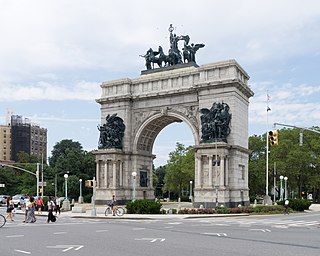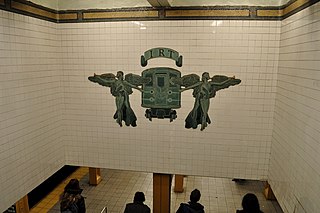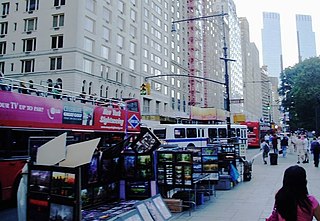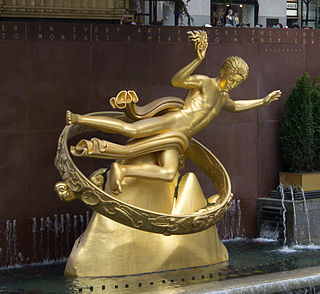
Prospect Park is an urban park in Brooklyn, New York City. The park is situated between the neighborhoods of Park Slope, Prospect Heights, Prospect Lefferts Gardens, Flatbush, and Windsor Terrace, and is adjacent to the Brooklyn Museum, Grand Army Plaza, and the Brooklyn Botanic Garden. With an area of 526 acres (213 ha), Prospect Park is the second largest public park in Brooklyn, behind Marine Park.

Grand Army Plaza, originally known as Prospect Park Plaza, is a public plaza that comprises the northern corner and the main entrance of Prospect Park in the New York City borough of Brooklyn. It consists of concentric oval rings arranged as streets, with the namesake Plaza Street comprising the outer ring. The inner ring is arranged as an ovoid roadway that carries the main street – Flatbush Avenue – with eight radial roads connecting Vanderbilt Avenue; Butler Place; two separate sections of Saint John's Place; Lincoln Place; Eastern Parkway; Prospect Park West; Union Street; and Berkeley Place. The only streets that penetrate to the inner ring are Flatbush Avenue, Vanderbilt Avenue, Prospect Park West, Eastern Parkway, and Union Street.

Grand Army Plaza is a local station on the IRT Eastern Parkway Line of the New York City Subway. It is located in Park Slope, Brooklyn, underneath Flatbush Avenue at its intersection with Plaza Street West and St. Johns Place, on the northwest side of Grand Army Plaza. It is served by the 2 train at all times, the 3 train at all times except late nights, and the 4 train during late nights.

The Plaza Hotel is a luxury hotel and condominium apartment building in Midtown Manhattan in New York City. It is located on the western side of Grand Army Plaza, after which it is named, just west of Fifth Avenue, and is between 58th Street and Central Park South, at the southeastern corner of Central Park. Its primary address is 768 Fifth Avenue, though the residential entrance is One Central Park South.

Mount Prospect Park is a 7.79-acre (3.15 ha) park in the central portion of the New York City borough of Brooklyn. It includes Mount Prospect, the second highest point in Brooklyn. It is located on Eastern Parkway near Underhill Avenue, close to Grand Army Plaza. The park is operated by the New York City Department of Parks and Recreation.

The Soldiers' and Sailors' Memorial Monument is a monument located at 89th Street and Riverside Drive in Riverside Park in the Upper West Side of Manhattan, New York City. It commemorates Union Army soldiers and sailors who served in the American Civil War. It is an enlarged version of the Choragic Monument of Lysicrates in Athens, and was designed by the firm of Stoughton & Stoughton with Paul E. M. DuBoy. The monument was completed in 1902.

The Governor Nelson A. Rockefeller Empire State Plaza is a complex of several state government buildings in downtown Albany, New York.

59th Street is a crosstown street in the New York City borough of Manhattan, running from York Avenue/Sutton Place on the East Side of Manhattan to the West Side Highway on the West Side. The three-block portion between Columbus Circle and Grand Army Plaza is known as Central Park South, since it forms the southern border of Central Park. The street is mostly continuous, except between Ninth Avenue/Columbus Avenue and Columbus Circle, where the Time Warner Center is located. While Central Park South is a bidirectional street, most of 59th Street carries one-way traffic.

Eastern Parkway is a major road that runs through a portion of the New York City borough of Brooklyn. Designed by Frederick Law Olmsted and Calvert Vaux, it was the world's first parkway, having been built between 1870 and 1874. At the time of its construction, Eastern Parkway went to the eastern edge of Brooklyn, hence its name.

Grand Army Plaza is a square at the southeast corner of Central Park in Manhattan, New York City, at the intersection of Fifth Avenue and Central Park South, covering two blocks on the west side of Fifth Avenue between 58th and 60th Streets. It contains an equestrian statue of William Tecumseh Sherman on its northern half and the Pulitzer Fountain on its southern half.

The Soldiers' and Sailors' Arch is a triumphal arch at Grand Army Plaza in Brooklyn, New York City, just north of Prospect Park. Built from 1889 to 1892, the arch is dedicated "To the Defenders of the Union, 1861–1865".

Bailey Fountain is an outdoor sculpture in New York City at the site of three 19th century fountains in Grand Army Plaza, Brooklyn, New York, United States. Renovated in 1956 and 2005-06, the 1932 fountain was funded by philanthropist Frank Bailey as a memorial to his wife. After 1974 thefts, some sculpture elements were stored for safekeeping.

The Williamsburg Bridge Plaza, sometimes called Washington Plaza or the Williamsburg Bridge Transit Center, is a major bus terminal and former trolley terminal located at the foot of the Williamsburg Bridge in the New York City borough of Brooklyn, one block west of the Brooklyn-Queens Expressway (I-278). It is situated by the boundaries of Broadway, Havemeyer Street, Roebling Street, and South 5th Street, south of the LaGuardia Playground. It contains five bus lanes, and serves as a terminal for numerous MTA New York City Transit Authority bus routes of Brooklyn and Queens that start and end their runs there.

Prometheus is a 1934 gilded, cast bronze sculpture by Paul Manship, located above the lower plaza at Rockefeller Center in Manhattan, New York City. Created by Roman Bronze Works in Queens, the statue is 18 ft (5.5 m) tall and weighs 8 tons. It depicts the Greek legend of the Titan Prometheus, who was the son of the Titan Iapetus and the Oceanid Clymene, brought fire to mankind by stealing it from the Chariot of the Sun, which resulted in Zeus chaining Prometheus and sending an eagle to prey upon his continually regenerating liver.

William Tecumseh Sherman, also known as the Sherman Memorial or Sherman Monument, is a sculpture group honoring William Tecumseh Sherman, created by Augustus Saint-Gaudens and located at Grand Army Plaza in Manhattan, New York. Cast in 1902 and dedicated on May 30, 1903, the gilded-bronze monument consists of an equestrian statue of Sherman and an accompanying statue, Victory, an allegorical female figure of the Greek goddess Nike. The statues are set on a Stony Creek granite pedestal designed by the architect Charles Follen McKim.

Pulitzer Fountain is an outdoor fountain located in Manhattan's Grand Army Plaza in New York. The fountain is named after newspaper publisher Joseph Pulitzer who died in 1911 having bequeathed $50,000 for the creation of the fountain. Pulitzer intended his fountain to be "like those in the Place de la Concorde, Paris, France." The fountain was designed by the architect Thomas Hastings, and crowned by a statue conceived by the sculptor Karl Bitter. The fountain was dedicated in May 1916. One hundred years later it looked like this:

The equestrian statue of Henry Warner Slocum is a monumental statue in Brooklyn's Grand Army Plaza, in New York City. The equestrian statue, designed by sculptor Frederick William MacMonnies, was dedicated in 1905 in honor of Henry Warner Slocum, who served as a general in the Union Army during the American Civil War and later as a U.S. Representative from the state of New York.
A statue of Gouverneur K. Warren by artist Henry Baerer is installed in Brooklyn's Grand Army Plaza, in the U.S. state of New York. The bronze sculpture of Warren in military garb rests on a Conway green granite pedestal quarried from Little Round Top. It was cast in 1893, commissioned by the G.K. Warren Post, No. 286, G.A.R. for $10,000, and dedicated on June 26, 1896. The memorial was cleaned in 1938, and conserved in 2001.

The Brooklyn War Memorial is a war memorial installed in Brooklyn's Cadman Plaza, in the U.S. state of New York. It features two high relief figures sculpted by Charles Keck, which represent victory and family, as well as a memorial wall in its main auditorium. The memorial was dedicated in 1951, and later restored in 1977.

The John F. Kennedy Memorial by Neil Estern is installed in Brooklyn's Grand Army Plaza, in the U.S. state of New York. It features a bronze bust of John F. Kennedy on a Regal Grey granite pedestal. The current monument was dedicated on August 24, 2010, which replaced one previously dedicated on May 31, 1965.




















